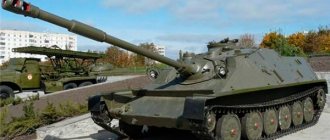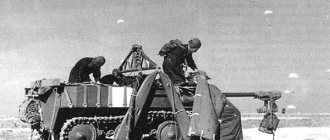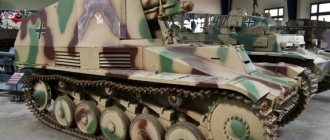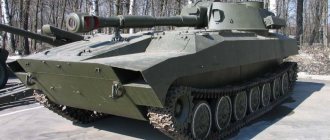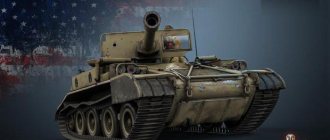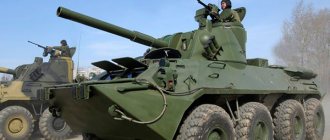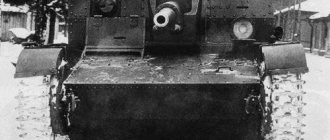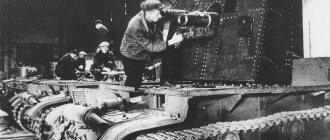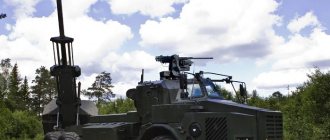The desert state of Nevada has long been used by the US military as a testing ground, from aviation to nuclear missiles. For this purpose, military bases have been built, which are strictly classified, but are unlikely to be of interest to anyone except spies. Yet one base has captured the world's attention for decades, to the point where a million-strong coalition of activists is preparing to storm it in September. Why has Area 51 become so popular - and what is really there?
Groom Lake (left) and Papoose Lake (Doc Searls)
Area 51 is located in southern Nevada, approximately 135 kilometers north of Las Vegas.
In the middle of the 19th century, deposits of silver and lead were discovered there, after which the English began to develop them, giving the local dry lake the name of its founder. Later, Jonas Osborne bought the right to develop the deposits, and his son continued mining until 1918. The first airfield near Groom Lake was built in 1942: the Indian Springs Air Force Base, which trained crews of the B-25 (Mitchell) twin-engine bombers, established “auxiliary airfield No. 1” there. Five years later, after the end of the war, the base was disbanded - but not for long. A year later, military personnel appeared on its territory who were testing atomic weapons, ballistic missiles and advanced aviation technology.
Military exercises using atomic weapons at the Nevada Test Site in November 1951
The fact is that since January 1951, explosions of atomic charges were constantly carried out at the neighboring Nevada test site. Returning from these tests, the pilots of flight group No. 4925 repeatedly saw Grum Lake glistening with salt and, of course, remembered it. Among them was professional test pilot Osmond Ritland, who was responsible for coordinating the actions of the Air Force and the CIA.
In April 1955, when the developers of the newest U-2 spy plane were looking for a site for their brainchild, he proposed “Field No. 1.” The project leaders immediately liked the place, and in June of the same year, large-scale construction began at the “Paradise Ranch” (as the selected area was nicknamed by CIA officers): the runway was updated, hangars, towers, a power plant and residential buildings were erected, roads and work sites were paved. .
The groom was closed to any aircraft whose pilots did not have special permission. Legally, the territory belonged to the Atomic Energy Commission, so a legend was planted on outsiders that the area was supposedly used for storing radioactive waste.
U-2 high altitude reconnaissance aircraft on dry salt lake Groom
The first U-2 aircraft, code 341, arrived there on July 24, 1955, and on August 4, after much preparation, it flew. Since the high-altitude reconnaissance aircraft was intended primarily for raids over the Soviet Union, the CIA was interested in the Reds learning about its existence as late as possible. During secret tests, the creators of the U-2 were convinced that the plane was practically invisible to the radars of that time, but at the same time it turned out that it could be seen with the naked eye even at the highest altitude.
Most reports of the strange aircraft came from civilian airline pilots, who usually spotted the U-2 after sunset on an east-west flight. Passenger airliners of the 1950s flew no higher than six kilometers; when dusk came, they found themselves in darkness, and the scout at an altitude of 20–21 km was still illuminated by the sun. Its long wings reflected the sun's rays, so the pilots saw a sparkling object rush past with lightning speed and immediately disappear from sight. An absolutely fantastic picture! Many pilots had fought before and knew for sure that planes do not fly higher than 14 kilometers and do not accelerate to that speed. The question arose: what is it?
Posters for science fiction films from the 1950s, dedicated to the invasion of flying saucers
In those years, Western society was experiencing “plate mania.” Ufologists assured the world that every strange celestial phenomenon is associated with aliens who flew to us from Mars or Venus on disk-shaped spaceships. The press multiplied reports of eyewitnesses who not only observed “flying saucers”, but also met their crews - dwarfs with gray skin and huge heads. Science fiction writers also vigorously exploited the public's interest in aliens: in the 1950s, many books about aliens were published, and there were dozens of films - from the classic "The Day the Earth Stood Still" (1951) to the rollicking "Teenagers from Outer Space" (1959).
Popular culture formed a stereotype in the public consciousness about hostile aliens on flying saucers, so flights over Nevada of a sparkling UFO (literally - the object was unidentified) immediately generated a powerful wave of reports from eyewitnesses. In addition, among the witnesses were airline pilots who could not be trusted. At the same time, neither the Air Force nor the CIA could give away military secrets and got off with formal replies, often completely ridiculous. Because of this, the public became increasingly convinced that the authorities were hiding information about the aliens.
The U-2 high-altitude reconnaissance aircraft ceased to be a secret when one, flown by Francis Powers, was shot down over the Soviet Union on May 1, 1960; the pilot was captured and brought to trial. Reconnaissance flights were immediately stopped. Although the secret of the U-2 was revealed, the CIA made sure that no one connected its tests with a secret facility at Groom Lake. Since August 1959, work has been in full swing there on the new OXCART project: the military was developing the A-12 aircraft, invisible to radar and capable of accelerating to speeds three times the speed of sound. Work on the complete reconstruction of the Paradise Ranch for new tasks was assigned code number 51, after which the base acquired a new unofficial name - Area 51.
Unmanned reconnaissance D-21 on an A-12 carrier aircraft
The first flight of the A-12 took place on April 26, 1962. The secrecy was so strict that those Area 51 employees who were not directly involved in the project were locked in a common dining room before the start of the next tests so that they could not find out what the promising aircraft looked like. Of course, the collection of observations of “flying saucers” was immediately replenished with new evidence.
The project, however, did not live up to the hopes placed on it - the aircraft was used only in Vietnam and over North Korea, and in the summer of 1968 the A-12 program was closed in favor of the more advanced and high-speed reconnaissance aircraft SR-71 (Blackbird), which, unlike his predecessors, was almost immediately declassified at the initiative of the presidential administration.
The project of the unmanned vehicle D-21 (Tagboard), which was supposed to take off from the A-12 and independently enter Soviet airspace, also turned out to be unsuccessful. The first phase of "drone" testing at Area 51, which began in the summer of 1964, revealed major technical problems; Over time, they were resolved, but on July 30, 1966, the D-21 collided with its carrier, resulting in the death of one of the A-12 pilots. In 1971, the project was finally closed.
MiG-21 over Area 51 in 1968
In addition to testing reconnaissance aircraft, specialists were engaged in another long-term top-secret project - the study of Soviet combat aviation on samples received from the allies. For example, in August 1966, Iraqi pilot Munir Redfa defected to Israel on a MiG-21, and in December 1967, his aircraft was delivered to Area 51. The US Air Force and Navy established the joint project HAVE DOUGHNUT, within which training battles were carried out between the hijacked MiG and similar American aircraft. The training helped to find out that the Soviet fighter showed better performance at low speeds, so the experts came up with a recommendation: never slow down when fighting it.
At the beginning of 1969, two Syrian MiG-17 fighters appeared in Area 51, whose pilots got lost in flight and landed on an Israeli airfield. To study new trophies, the HAVE DRILL program was launched. Training battles over a ridge near Lake Groom revealed the main drawback of the MiG-17: poor controllability during active maneuvering.
Since the United States was fighting a war in Vietnam, where pilots constantly had to deal with the enemy in Soviet fighters, the Top Gun flight school selected several crews who took part in training battles over Area 51. After these exercises, another name was assigned to the facility - “ Red Square.
F-117 stealth aircraft over Area 51 in 2002
However, the main function of the base remained the same, and in December 1977, a prototype of the Have Blue stealth fighter appeared on its runway. Its tests helped create the famous “stealth” F-117 (Nighthawk) - the first production attack aircraft to use radar “invisibility” technology. Since June 1981, he also made test flights at Area 51 and remained highly classified for a long time, so his raids over Nevada gave rise to many rumors.
By that time, the base began to attract the attention of researchers interested in so-called “black” projects - the development of promising technology, the existence of which the authorities deny. Area 51 has given enthusiasts plenty of food for thought. For example, the hypothetical Aurora project sparked widespread discussion: experts claimed that the authorities were developing a hypersonic aircraft using stealth technology and capable of rising to space altitude. The reality of this project was indicated by the corresponding item of expenditure in the American budget for 1985, but the Pentagon did not recognize the existence of Aurora for a long time,” and later it was stated that it was about the stealth strategic bomber B-2 (Spirit).
Such a prosaic explanation did not satisfy independent researchers: they believe that the Aurora continues to fly, remaining classified. Numerous sightings of triangular UFOs are associated with it. Moreover, some ufologists believe that alien technologies were used to create a hypersonic aircraft.
Despite the secret activities at Area 51, for a long time no one would have thought that it could be somehow connected with aliens from outer space. Everything was changed by electronic engineer Robert Lazar, who in May and November 1989 appeared on the program of journalist George Knapp on the Las Vegas television channel KLAS-TV. Lazar said that, as an experienced nuclear physicist, he was sent to the specially protected C-4 facility, which has several underground levels and is located 14 kilometers south of the Paradise Ranch, near another dry Papoose Lake.
Electronics engineer Bob Lazar claims to have been studying an alien flying saucer at Area 51
Lazar was allegedly given the task of building an anti-gravity engine according to drawings made on the basis of studying an alien flying saucer. The “plate” engine was powered by the decay of atomic element 115 (it was first synthesized in 2003 by Russian scientists, which is why it was called “Moscow”), and the saucer itself was made of a metal similar in hardness to stainless steel. Among other things, Lazar claimed that in the process of research he became familiar with documents that spoke of thousands of years of contacts with the inhabitants of the planetary system near the Zeta constellation Reticuli (? Reticuli). One day, in March 1989, Lazar had a chance to see the alien himself - a gray-skinned dwarf with a huge head, who was talking about something with scientists in white coats.
According to the electronics engineer, he could not bear the “burden of secrecy” and told his wife Tracy about everything, as well as close friends Gene Huff and John Lear - the latter, by the way, was a ufologist. Together they took a trip along Route 375, which leads to the mountains adjacent to Area 51. Lazar knew the schedule of night flights of the “saucers,” and his friends were able to make sure that he was not lying: before their eyes, a brightly lit disk rose above a dry lake, hung in the air and smoothly sank back down. On April 5, the company tried to enter the base itself, but was stopped on the way, after which everyone was sent to the local sheriff's office.
The next day, Lazar learned that he was being transferred to Indian Springs. There he was interrogated, given immediate dismissal, and warned that he should never go near Area 51 again or face arrest on espionage charges. Subsequently, “government agents” constantly monitored him and even managed to quarrel between Lazar and his wife.
Declassified CIA diagram of Area 51 in 1966
Bob Lazar's revelations caused a stir among Las Vegas television viewers. However, he gained worldwide fame after the Japanese channel Nippon TV became interested in the history of Area 51 and in February 1990 conducted secret video filming in the surrounding mountains. The Japanese managed to film the takeoff of an object with bright orange lights, which made a strong impression on the operators. The program with this recording and a fresh interview with Lazar, in which he complained of persecution by the American authorities, was watched by thirty million Japanese, which created a sensation. Hundreds of journalists and independent researchers began studying the life of a modest electronics engineer and checking his testimony.
It immediately became clear that Lazar was engaged in a private photography business and was never listed as a nuclear physicist: he did not have a diploma or membership in a trade union. To this he replied that the special services deliberately destroyed all archival data in order to expose him as a liar and a half-educated person. The electronics engineer then appeared in court on charges of pimping (actually pimping) in a prostitution case. To avoid getting a real prison sentence, he made a deal and pleaded guilty. As a result, Lazar got off with community service, but due to the scandal that erupted, he was forced to limit contacts with the press.
In 1993, he sold the rights to his story to New Line Cinema and took two lie detector tests to confirm its veracity. The result turned out to be ambiguous, and the public, who followed the development of the situation, was divided into two camps: some believed in Lazar’s story, others believed that he made it all up for the sake of fame and money.
Paradoxically, the details outlined by Bob Lazar in an interview can serve as confirmation of any of these mutually exclusive versions. First of all, the story he tells is largely based on modern folklore associated with the “little gray men”.
Lazar's story refers us to the classics of ufology - to the story of the spouses Betty and Barney Hill, who claimed that on the night of September 19-20, 1961, they observed the landing of a flying saucer, after which they were abducted and examined by short, gray-skinned humanoids in black suits. At the same time, Betty Hill stated that one of the aliens showed her a star map, and was even able to restore it under hypnosis. This allowed amateur astronomer Marjorie Fish to put together a model and conclude that the aliens' home star was Zeta Reticuli.
Elementary school teacher Marjorie Fish's interpretation of Betty Hill's star map
Fish’s reconstruction appeared on the pages of the authoritative journal Astronomy, after which experts checked her calculations and published their critical reviews in December 1975. For example, the famous Carl Sagan showed that, purely statistically, it is always possible to find a group of stars in the sky that corresponds to any cluster of points randomly plotted on paper.
Bob Lazar probably knew nothing about the astronomers' research and supported Fish's reconstruction with his story. Two equal conclusions follow from this: either the Hill couple spoke the absolute truth and the teacher was right in pointing out Zeta Grids, or the electronics engineer lied, using stereotypes created by ufologists and advertised by science fiction writers.
Firepower
Previously, this self-propelled gun stood out among the seventh level artillery due to its enormous damage: the 203-mm B-4 howitzer was installed on it as a top weapon. Actually, the goal of each player on this machine was simple - to explore, install this weapon and inflict 600-700 damage per shot, and if you were lucky, you could even one-shot the enemy.
After the update, Pinocchio remains the most powerful self-propelled gun at the seventh level, along with the SU-14-1. But one-time damage decreased to 1050 units. The armor penetration index of the projectile is 52 mm. In other words, you can actually forget about one-shots; this will only happen with completely cardboard machines like Leo or Rhm.-B.WT. But at the same time, the update improved accuracy, reduced aiming time and increased the radius of scattering of fragments (splash). True, although the reload speed has decreased, it still remains significant - about 50 seconds. Another drawback is the modest horizontal aiming angles, only three degrees in each direction.
Another change occurred with Pinocchio - the stock BR-2 gun began to sparkle with new colors. Previously, it was a pass-through and was of little interest to anyone, but now many players prefer it. The BR-2 is much more accurate than the B-4 and aims faster, which is of great importance in conditions of modest horizontal aiming angles. The reload lasts 24 seconds, and the one-time damage is 700 units. In other words, in terms of DPM, the BR-2 is almost one and a half times greater than the B-4. If the crew has the “Combat Brotherhood” skill and a howitzer rammer is installed on the self-propelled gun, then the reload speed is reduced to 21 seconds, which is simply an excellent indicator.
As for the equipment, regardless of the gun, two main mechanisms are installed on the self-propelled guns: a howitzer rammer and reinforced aiming drives.
Mysterious lights
0
Source:
Having asked not to use their names, Nellis Air Force Base specialists said that on radar screens they had more than once observed how objects flying at incredible speeds over Area 51 suddenly, as if on command, stopped and hovered in the air. Mark Barnes, a powerful radar operator from Las Vegas, observed the same thing. Here are typical statements from people who worked in Nevada: “We have things there that are literally not from our world.” One of the passengers on an American Airlines flight flying from San Jose (California) to Houston (Texas) captured mysterious lights and a giant disk on the ground in the area of the top-secret Area 51, which is located in the south of Nevada, the British newspaper reported. Daily Express". An eyewitness took a series of photographs that were published by the publication. The man said that everything happened on October 30, 2015. “During the flight, I suddenly noticed a blinding bright light in the desert. A large silver disk caught my eye; several luminous balls were visible above it. I grabbed my phone and started filming. At first I thought it was a satellite, but then I doubted it,” said an eyewitness. According to him, other passengers most likely did not see anything. The pilots and aviators interviewed by eyewitnesses stated that they had not encountered anything like this in their practice. In the absence of official explanations, rumors begin. Of course, it is understandable that some information must be kept secret to keep the public from rioting due to fears and speculation, but honesty is always the best policy.
×
Game tactics
Despite the introduction of a stun mechanic, the main parameter for this self-propelled gun remains damage. Gameplay depends on the choice of weapon. As before, the B-4 must be brought to positions in advance where active firefights usually take place. The difference from past times is that now it is not necessary to choose a specific goal. Having discovered several enemy tanks standing next to each other, you need to send a projectile between them; due to the splash, a successful shot can cause up to a thousand damage in total.
BR-2 provides greater variety of gameplay. Given its fast reload time and good accuracy, it allows the player to control almost the entire map. It is not necessary to wait until the enemy vehicles light up again; you can simply turn your attention to another direction and shoot there.
For tank lovers, you should also like other games. We recommend watching games about war on this site.
Even after the upgrade, the S-51 remains a very formidable artillery piece. The artillery rebalance even benefited her. And although it no longer destroys tanks with one shot, if we take the battle as a whole, there are more opportunities to cause damage and now this self-propelled gun demonstrates more stable results than before.
Self-propelled gun 2S9 Nona-S 120 mm performance characteristics. Firing range. Dimensions. Weight. Armament
The 2S9 Nona-S self-propelled gun is considered a unique artillery system that was created specifically for direct fire support of airborne troops on the battlefield. The need for such a vehicle arose when plans emerged to use “winged infantry” on enemy territory. In this case, a huge role was assigned to airborne self-propelled artillery installations. However, the existing models ASU-57 and ASU-85 were designed to fight tanks. In addition, they were not entirely convenient for landing, since this required the landing of a transport aircraft on the runway, which excluded surprise. That is why in the mid-60s. work began aimed at creating a more convenient and at the same time powerful machine.
Canadian Hellier
0
Source:
Paul Hellier, Canada's former defense minister, told the world: "Two aliens are working for the US government." Sensational confessions were made at the “Civil Hearings on Declassification” conference in Washington. A video of his speech went viral on YouTube. His speech basically boils down to a postulate: aliens exist, the military knows about them, and there are living aliens living on Earth at the present time. At least two of them work for the US government. Paul said: “My interest is in full declassification. The only caveat is that it should probably be 95-98% disclosed. I know of one or two things that shouldn't be talked about openly, at least for now." Unfortunately, the sources from which Hellier draws his confidence about aliens are quite murky and often simply false. UFOs certainly exist, but it is unlikely that things have gone as far as Hellier believes. But there is certainly truth in his words.
P-51 Mustang fighter design
The P-51 Mustang fighter was built according to the aerodynamic design of a cantilever low-wing aircraft, and in the full sense was all-metal, even all control surfaces were made of metal - from the steering wheel to the flaps. The wing is straight, three-spar, trapezoidal in plan, formed by a laminar NACA profile. The wing mechanization consisted of 2 ailerons and 2 flaps, all control surfaces were equipped with trimmers.
American World War II fighter P-51 Mustang
The landing gear is retractable, tricycle with a steerable tail wheel. The power plant consisted of a piston V-shaped 12-cylinder liquid-cooled Allison V-1710 engine with a three-blade propeller; later they began installing the Packard V-1653 (licensed Rolls-Royce Merlin Mk.XX), with a four-blade Hamilton-Standard propeller with a diameter of 3 .4 m.
The radiator was installed in a tunnel under the fuselage. The fuel supply was located in 2 wing and 1 fuselage tanks. The pilot's cabin is closed. Starting with the P-51D modification, a teardrop-shaped, unbound canopy was installed. The armor included a 6.3 mm thick front armor plate, bulletproof glass (38 mm), a fire partition (6.3 mm), a rear armor plate (8 mm) and an armored headplate (11.1 mm).
The composition of the weapons varied depending on the modification and included 7.62 mm Browning M-40 machine guns, 12.7 mm Browning M-53 (M-53.2) machine guns, 20 mm cannons, free-fall bombs, unguided 127 mm HVAR rockets .
More about plane crashes
0
Source:
On May 1, 1960, CIA pilot Francis Powers began a planned flight from Pakistan and soon approached the Soviet border. The purpose of his flight was the territory of the Soviet Union: photographing objects and recording radio broadcasts. The route was supposed to pass through the Aral Sea, Sverdlovsk, Kirov, Arkhangelsk and Murmansk, and the plane was scheduled to land at the Norwegian airport Bodø. The plane was not destined to land. It was discovered already during the border crossing in the area of modern Pyanj. A little over three hours after that, he was shot down by the very first missile fired from the S-75 complex. For greater confidence, the air defense forces then fired eight missiles (and accidentally shot down a MiG-19, raised to intercept. The MiG pilot, senior lieutenant Safronov, was killed). Powers' fate turned out much better. The missile was fired at the plane and exploded near its tail. As a result, the cabin was not damaged, and Powers waited until the altitude was 10 km and left it. On the ground he was detained by local residents. As a result, he was sentenced to 10 years in the camps, but less than two years later he was “swapped” in Berlin for the Soviet intelligence officer William Fischer (Rudolf Abel). In 1984, the deputy commander of the Air Force command system, Lieutenant General Robert Bond, was killed while flying a Soviet MIG. The accident occurred in the mountains close to Groom Lake. The authorities could not hide the death of the general, but they also did not want to admit that the United States had a Soviet fighter. The official report stated that Bond crashed in a "specially modified US Air Force aircraft." Experts immediately appeared and “figured out” the plane as “a prototype of a top-secret stealth fighter.” Apparently, it is precisely from those media reports that “legs are growing” about the involvement of the MiG-23 in the F-117 development and testing program. Probably, such flights were carried out, just as they were carried out under other programs, for example the F-15E, but they were of a purely “evaluative” nature. It is not clear which MiG-23 Bond crashed on. After the accident, the area around Groom Lake was classified, and guards were stationed on the road leading to Area 51.
Crew Perks
Commander
- Sixth Sense
- The Brotherhood of War
- Disguise
Gunner
- Disguise
- The Brotherhood of War
- Sniper
Gunner
- Disguise
- The Brotherhood of War
- Smooth rotation of the tower
Driver mechanic
- Disguise
- The Brotherhood of War
- Virtuoso
Charging
- Disguise
- The Brotherhood of War
- Optional
Charging
- Disguise
- The Brotherhood of War
- Optional
As always, we put “camouflage” and “light bulb” first. The second skill we download for everyone is “Combat Brotherhood”. If you get to the third, then it wouldn’t hurt to take “smooth turret rotation” (even taking into account our tiny horizontal cover angle), “sniper” and “virtuoso”. The rest of the skills are up to your taste.
Operation and combat use of the Spitfire fighter
The P-51 Mustang's first combat mission took place on May 5, 1942. From that time on, it was used by the British and Americans on all fronts of the Second World War. The two-seat P-51D was used as the personal one by General D. Eisenhower during the Normandy landings.
Since 1946, American aircraft began to be transferred from the Air Force to the National Guard, where they were operated until January 1957. In 1950, some US National Guard P-51Ds were transferred to South Korea, which used them in the Korean War until June 1951. Both English and South African Mustangs fought there. In 1956, the Israelis used Mustangs in the war against Egypt.
In Great Britain, the Mustang was withdrawn from service in May 1951, in New Zealand - in 1955, in Canada - in 1956. In 1952-1954, Sweden sold its Mustangs to the Dominican Republic (they flew until the early 70s), Nicaragua (in service until 1965) and Israel. The French also sold their F-6Ds to Israel and Somalia. Israeli "Mustangs" were withdrawn from service in 1956, and were used in training units until 1958. In 1958, Uruguay sold the remaining 6 of its aircraft to Bolivia, where they were operated until 1977. In Indonesia, P-51s also served until the late 70s.
The Mustang was not supplied to the USSR under Lend-Lease. In the first half of 1942, the British transferred 10 Mustang Mk.II aircraft to the USSR, but during tests at the Air Force Research Institute, the fighters showed worse flight characteristics than the Yak-7B and Me-109G.
Source: compilation based on open sources on the Internet, as well as “Fighters of the Second World War 1939-1945”, AVIAM, 1994.
Characteristics of P-51
A country:USAType:FighterYear of issue:1941Crew:1 personEngine:V-1650-7 with 1150 hpMaximum speed:703 km/hPractical ceiling:12750 mRange of flight:1520 kmEmpty weight:3466 kgMaximum take-off weight:5493 kgWingspan:11.27 mLength:9.83 mHeight:4.16 mWing area:21.83 sq.m.Weapons:6x 12.7 mm machine guns, 6x 127 mm NURS, 2x 454 kg. bombs.
Specifications shown for model P-51D
| S-51, KBP-39, UTS-19 type “C” IX-bis series |
photo:
historical reference:
1937 April 29
Laid down on the boathouse of the Baltic Shipyard No. 189 named after. S. Ordzhonikidze to Leningrad, but was soon delivered disassembled to Shipyard No. 202 named after. K.Voroshilov to Vladivostok for completion. According to other sources, it was laid down on March 24, 1937;
1940 August 30
Launched;
1941 November 30
The acceptance certificate has been signed. Entered into service;
1941 December 6
She became part of the Pacific Fleet and was assigned to the Separate Training Submarine Submarine of the Pacific Fleet, based in Vladivostok. Then it was transferred to the 3rd DnPL of the 1st BrBM of the Pacific Fleet with the same location;
1941 December 16
The Naval flag is raised;
1942 January 28
The acceptance certificate has been approved;
1942 June
Made a 30-day trip to the Sea of Japan to observe the actions of Japanese warships and transport vessels in order to establish whether troops and equipment were being transferred from the ports of Japan to the ports of Korea;
1942 July
After returning, she was docked in preparation for transfer to the Northern Fleet. Initially, it was planned to transport it along the Northern Sea Route and even planned to install an ice belt;
1942 October 5
After the exit of the first group of submarines consisting of
“S-54” and “S-55” , together with the submarine “S-56”, they entered the Eastern Bosphorus Strait and anchored.
On board was the head of the transition, commander of the 3rd DnPL 1st BrPL Pacific Fleet Hero of the Soviet Union cap.1r. Tripolsky A.V. The commander of the Pacific Fleet, Vice Adm., arrived at the raid. Yumashev I.S., member of the military council, corps commissar S. Zakharov and chief of staff of the Pacific Fleet, rear adm. Bogdenko V. and wished the sailors a happy voyage; 1941 October 6
At 7.00 the group weighed anchor;
1942 October 9
Both submarines arrived in the Gulf of De-Kastrii;
1942 October 10
A pilot arrived on board and guided the submarine through the Tatar Strait;
1942 October 14
The submarines arrived in Petropavlovsk-Kamchatsky;
1942 October 17
After replenishing supplies, the boats headed for the American naval base at Dutch Harbor in the Aleutian Islands;
1942 October 23
Without escort from allied ships, the submarines arrived at Dutch Harbor;
1942 October 28
Accompanied by two American destroyers, the submarine departed for San Francisco;
1942 November 5
Entered San Francisco harbor;
1942 November 12
We continued our journey towards the Panama Canal;
1942 November 25
We passed through the Panama Canal and on the same day made a short stop at a base near the port of Colon;
1942 December 2
Accompanied by an allied destroyer, both submarines entered the Caribbean Sea.
During the transition to the Guantanamo Bay base, the S-51 was attacked by an unknown boat, the torpedo passed 30 meters along the bow;
1942 December 5
The submarines arrived in Cuba and refueled and continued on to Canada.
During the transition, the submarines were caught in a storm, and the S-51 was again attacked by an unknown submarine, which it avoided by maneuvering;
1942 December 12
The submarines arrived in Halifax, where they were put in for repairs.
Cap.1r. Tripolsky A.V. transferred aboard the submarine “L-15” for further passage;
1942 December 29
She began a solo passage, accompanied by an English destroyer;
1943 January
Arrived in Iceland in Hvalfjord Bay and moored alongside the American mother ship AR-5 “Vulcan”;
1943 January 16
She left Iceland with the same accompaniment;
1943 January 24
Accompanied by the EM "Razumny" she arrived at Catherine Harbor. In 108 days, 15,978 miles were covered, of which 227 miles were under water. Upon arrival at the Polyarny submarine on the same day, it was included in the 2nd DnPL BrPL SF and put into routine repairs;
1943 April 25
Current repairs have been completed, during which the Dragon-129 GAS was installed;
1943 May 9 - 22
At 21.20, 9.5 left for the first combat trip to the North Cape area at position No. 3. Immediately after trimming from the bridge, it was noticed that on the starboard side, a torpedo had half come out of the upper torpedo tube - apparently, the tail stopper had spontaneously released. The torpedo was fired along the shore. 13.5 at 08.10 discovered and at 08.30 launched a torpedo attack on a convoy in the area of Cape Sletnes in Tanafjord. The submarine commander determined the composition of the convoy in 4 TRs, guarded by 6 TFRs and 2 aircraft. The attack was carried out from an underwater position from a depth of 20 meters due to the lack of a BTS device with 4 torpedoes with a time interval of 7 seconds. from a distance of 12 cables, after 50 and 90 seconds. 2 explosions were heard. The convoy, which included the African, Brigid, Margaret and Ludwig, was attacked to no avail. German ships observed 2 torpedo tracks. The submarine was subjected to a 3-hour pursuit by the German TSC “M 343”, BO “Uj 1212”, which, according to German data, dropped 11 depth charges (according to the report of the submarine commander - 9 GLB). The submarine commander reported the sinking of the transport and damage to the patrol ship. 19.5 at 71˚12.2'N, 28˚13.5'E. touched the mine on the M-6 barrier, but there was no explosion. 22.5 at 14.28 arrived in Polyarnoye;
1943 June 17 - 29
At 00.42 17.6 went on a second combat campaign in the area of Cape Makkaur - Cape Tanahori to position No. 3. At the position during one of the urgent dives, due to a foreign object getting under the plate of the filling valve of the rapid dive tank, it fell to a depth of 98 meters, but was won. On 23.6 at 14.50 the periscope was discovered, and at 15.33 in the area of Cape Sletnes an enemy convoy was attacked, the composition of which was assigned by the submarine commander to 2 TR guarded by 3 TS. The attack was carried out from a depth of 18 meters with 4 torpedoes with a time interval of 8 seconds. from a distance of 12 cables, after 90 seconds. 2 explosions were heard, after another 110 seconds. - third. At 15.53, only the outgoing transport and 2 technical units were observed through the periscope. A German convoy was unsuccessfully attacked, including the damaged TR "Wandsbeck", "Akka", "Stella", which were in tow from the tugboats "Travl I", "Floin II" and "Suursaari". At about 17.00 it was attacked by the TFR “V 6107”, which dropped 19 gigabytes on the submarine at a safe distance. The submarine commander reported that one submarine had been sunk and another had been damaged. 25.6 at 13.21 at 71˚10.8'N, 28˚25.0'E. when crossing a minefield at a depth of 75 meters, a mine was heard touching the mine and after 2 minutes an explosion occurred behind the stern - the submarine was blown up on the spacecraft tube of a UMB mine. The electrical control of the vertical rudder, the Octopus device, and a number of instruments failed, the anti-aircraft periscope was damaged, and the cooling pipeline of the left diesel engine burst. 27.5 at 06.30 launched a torpedo attack on a convoy in the area of Cape Sletnes, the composition of which was determined by the submarine commander as 1 transport and 1 technical unit or RT. The attack was carried out from a depth of 18 meters with 4 torpedoes with a time interval of 9 seconds. from a distance of 12 cables After 100 and 120 sec. 2 explosions were heard, at 06.45 nothing was detected through the periscope, but there was no foreign data. There was no persecution. The commander reported the sinking of the transport. 29.6 at 08.30 arrived in Polyarnoye;
1943 July 1 Transferred to the 5th DnPL BrPL Northern Fleet with the same location;
1943 July 27 - August 2
At 19.45 27.7 went on the third combat campaign to the area north of the mouth of the Kola Bay to the “Zh” position. I had no meetings with the enemy. 1.8 at 18.00 began returning to base and at 10.35 2.8 arrived in Polyarnoye;
1943 August 30 - September 10
At 21.03, 30.8 went out on the fourth combat campaign in the area of Cape Omgang - Cape Seibones to position No. 5. 3.9 at 05.26 in the Kongsfjord area carried out a torpedo attack on a convoy, the composition of which was determined by the submarine commander to be 2 TR without escort. The attack was carried out from an underwater position with 4 torpedoes with a time interval of 8 seconds. from a distance of 8 cables. After 55 and 60 seconds. 2 explosions were heard. Subsequently, human intelligence confirmed the sinking of the TFR - the German BO "Uj 1202" "Franz Dankwort" was sunk by 1 torpedo hit. According to foreign data, there was no pursuit, but the submarine commander reported explosions of 20 GB. 5.9 at 10.53 launched a torpedo attack on a convoy of 2 TRs under the Norwegian flag from an underwater position with 2 torpedoes at a time interval of 8 seconds. from a distance of 10 cables. After 1 min. 1 explosion was heard. There are no foreign data. There was no persecution. The commander reported the sinking of the transport. 6.9 in the morning and afternoon was unable to attack 2 TSC due to the long distance. 8.9 at 12.20 launched a torpedo attack on the convoy, the composition of which was determined by the submarine commander as 2 TR, 5 TSCH and 3 SKA. In addition, nearby there was another group of German ships, according to the observations of the submarine commander, consisting of 1 TR, 3 TSCH and 1 SKA. The attack was carried out from an underwater position with 4 torpedoes with a time interval of 10 seconds. from a distance of 10 cables. After 71, 78 and 110 seconds. 3 explosions were heard. A German convoy was unsuccessfully attacked, including the TR "Harm Fritzen", "Rothenfels", "Mathias Stinnes", "Dockenhuden", "Tento", "Sevre", the tanker "Adlergrund", "Binz", "Tripp", guarded by a large number of anti-submarine ships. According to German data, 5 torpedoes were observed passing by. Counterattacked by enemy ships, which dropped at a safe distance, according to the commander's report, 62, and according to the Germans - 10 GB. The submarine commander reported the sinking of the transport. 9.9 at 03.40 began returning. 10.9 at 08.54 arrived in Polyarnoye;
1943 September 10 - October 1
The battery has been replaced;
1943 October 15 - November 23
Current repairs were carried out, after which the submarine was unable to enter service due to the lack of rotors for the Büchi blowers;
1944 January 19 - January 21
Passed docking;
1944 spring
The submarine was visited by the US Ambassador to the USSR A. Harriman and the Northern Fleet Commander Admiral A.G. Golovko. and the commander of the Karelian Front, Marshal K.A. Meretskov.
1944 March 16 - April 3
At 23.13, 16.3 went out on the fifth military campaign in the area of \u200b\u200bSerey Island - Andey Island to search for the German tank "Tirpitz", which, according to reconnaissance data, was supposed to reach Germany. On 23.3 in the morning, the submarine commander refused to attack the TSC due to the low value of the target. 30.3 at 02.45 began returning to base and at 04.30 3.4 arrived in Polyarnoye;
1944 April 12 - June 9
It underwent ongoing repairs, during which equipment for using ET-80 torpedoes was installed;
1944 August 17 - September 2
At 20.14, 17.8 went out on the sixth combat campaign in the Porsangerfjord area in sector No. 1 according to the plan for Operation RV-7 as part of the 4th overhanging curtain. 19.8 The submarine did not manage to take up a position in time to intercept the convoy, arriving there only in the afternoon of 19.8, while it had a discrepancy of 45 miles to the island. 26.8 at 07.58 north of the mouth of the Porsangerfjord, the German submarine “U 711” was unsuccessfully attacked. 28.8 in the evening was unable to attack the convoy in the area of Cape Sletnes due to the long distance and unfavorable heading angle. On August 29, the cable of the commander’s periscope broke and the periscope failed. 1.9 at 01.07 began returning. 2.9 at 04.45 arrived in Polyarnoye;
1944 September
After the trip, the submarine had to dock for repairs. But on the initiative of the mechanical engineer submarine cap. 3rd rank Karpechenkova I., it was decided to carry out urgent and preventive repairs on our own so that the submarine could take part in the final operation of the Northern Fleet in the Second World War;
1944 September 24 - October 13
24.9 went on the seventh combat campaign to the Porsangerfjord area in sector “A”, according to the plan of operation “RV-8” and 26.9 arrived at the position. On 4.10 in the afternoon, the submarine commander refused to attack the TFR due to the low value of the target. On 5.10, the submarine commander received orders to conserve fuel and supplies until 13.10, since it was planned to use it in Operation West. On 7.10 in the morning, 3 TFRs were not attacked due to the low value of the target. 10.10 at 10.57 launched a torpedo attack on the convoy at point 70˚02'N, 26˚56'E. in the area of the mouth of the Porsangerfjord, the composition of which was determined by the submarine commander as 2 TR, 1 MM, 1 TSCH and 1 SKR. The attack was carried out from an underwater position with 4 ET-80 torpedoes from a distance of 7.5 cabs. After 105 sec. 3 explosions were heard; at 11.06, observation through the periscope revealed the absence of the destroyer. The enemy attack was not recorded, since, having not found the characteristic traces of torpedoes, the enemy believed that floating mines had apparently exploded. The German convoy E-136 was unsuccessfully attacked. There was no persecution. The commander reported the sinking of the destroyer and damage to the TFR. 11.10 at 21.27 began returning to base and at 08.07 13.10 arrived in Polyarnoye;
1944 October 18 - 1945 February 20
Placed under current repair with docking;
1944 November 15
By decree of the Supreme Soviet of the USSR she was awarded the Order of the Red Banner;
1945 April 21
Came into operation after repair;
1945 Transferred to the 2nd DnPL ObrPL SF with the same location;
1947 (?) Transferred to the 3rd DnPL OBRPL SF with the same location;
1949 January 12
Reclassified to medium submarine;
1951 March Reformed into the 162nd BrPL of the 33rd DiPL of the Northern Fleet with the same location;
1952 Under repair;
1952 - 1953 Transferred to the Yokan naval base of the Northern Fleet (Gremikha);
1954 (?)
Towed to Svyatonossky Bay;
1954 September 7
Removed from combat personnel and reorganized into a combat training room;
1954 October 6
Renamed
"KBP-39" ;
1956 December 27
Reformed into UTS, renamed
"UTS-19" .
It was part of the 14th OBrPL of the Yokan Naval Base of the Northern Fleet; 1970
The training vehicle hull was pulled ashore by the submarine brigade
1972 February 11
Expelled from the Navy vessels.
Subsequently, part of the light hull was used to make a monument to the submarine "S-51" , and the submarine's hull was partially dismantled and abandoned on the shore of the Svyatonossky Bay;
1973
The cabin and part of the submarine's hull were installed as a memorial in the city of Gremikha (Ostrovnoy), Murmansk region.
Additional Information:
1. Information and photographs on the “Russian Submarine” website.
commanders:
1. Azarov V.S. (05.12.1938-26.05.1940) 2. Bratishko D.K. (05/26/1940-11/06/1940) 3. Kucherenko I.F. (27.12.1941–12.04 (16.03?).1944) 4. Kolosov K.M. (04/12/1944–1946) 5. Malyshev A.S. (1946?-1947?) requires clarification 6. Gerasimov L.N. (10.1947-07.1950) 7. Evseev I.A. (07.1950-12.1952) 8. Lazarev G.V. (12.1952?-1953)
List of sources:
1. Shirokorad A.B. “Ships and boats of the USSR Navy 1939-1945”, Harvest, Minsk, 2002. 2. Berezhnoy S.S. “Ships and vessels of the USSR Navy 1928-1945,” Military Publishing House, Moscow, 1988. 3. Platonov A.V. “Soviet warships 1941-1945”, part 3, almanac “Citadel”, St. Petersburg, 1998. 4. Dmitriev V.I. “Soviet submarine shipbuilding”, Military Publishing House, Moscow, 1990. 5. Platonov A.V., Lurie V.M. “Commanders of Soviet submarines 1941-1945”, Citadel, St. Petersburg, 1999. 6. “The combat path of the Soviet Navy”, Voenizdat, Moscow, 1974. 7. “Combat activity of submarines of the USSR Navy in the Great Patriotic War of 1941-1945,” vol. 1, Military Publishing House, Moscow, 1969. 8. Morozov M.E. “Submarines of the USSR Navy in the Great Patriotic War of 1941-1945”, part 3, “KM Strategy”, Moscow, 2005. 9. Balakin S.A., Morozov M.E. “Submarines of the “C” type”, Marine Collection, No. 2, 2000. 10. Berezhnoy S.S. “Submarines of Russia and the USSR”, manuscript 11. Kozlov I.A., Shlomin V.S. “Red Banner Northern Fleet”, Military Publishing House, Moscow, 1983. 12. Reports on the combat operations of submarines of the Northern Fleet 1941-1943. 13. Kovalev E.A. “Kings of the submarine in the sea of jacks of hearts”, Tsentrpoligraf, Moscow, St. Petersburg, 2006.
Return to the Main page of the site “Assault of the Depths”
© 2005-2021 Compiled by Andrey Nikolaev. All rights reserved. Reproduction of the page in whole or in part in any form or form only with the written permission of the author. © 2005-2021 Design by Andrey S. Nikolaev. All rights reserved. Reproduction in whole or in part in any form or medium without express written permission of author is prohibited.
